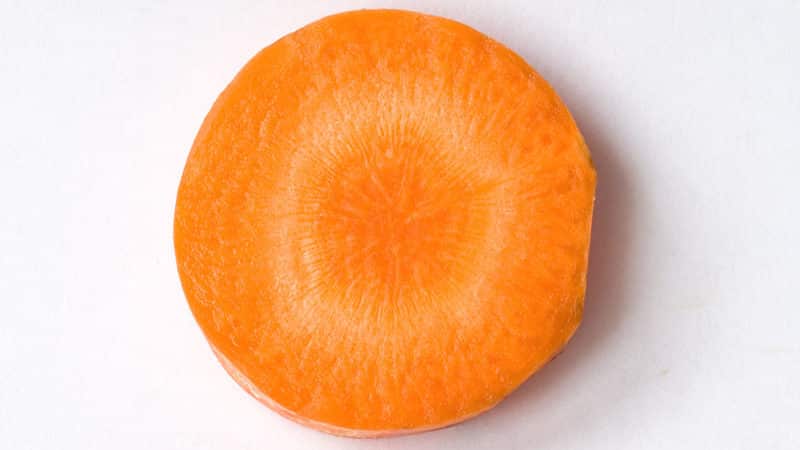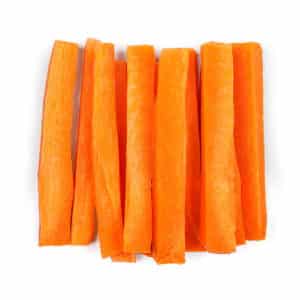White core of carrots - why does this happen?
Ripe carrot root is orange outside and inside. But it often happens that root vegetables grow in the garden not with an orange core, but with a white or pale yellow core. Having harvested such a harvest, summer residents wonder whether this vegetable is safe to eat and why the color of the pulp has changed.
For what reasons may carrots have a large and white core?

Wild carrots were originally white and their flavor was pungent. The vegetable acquired its usual orange color and sweet taste only in the 18th century thanks to Dutch breeders.
Reference! All modern vegetable varieties are hybrids to one degree or another. There are not only orange, but also yellow, white, red and even purple carrots. All of it is useful, but only if the flesh is evenly colored or its color is determined by persistent varietal characteristics.
Root vegetables with too large and white cores are not considered normal. If carrots with unusually colored flesh have grown in the garden bed, it is worth understanding the reasons for this phenomenon and trying to eliminate them.
Why are carrots white or yellow inside and not orange?
The structure of the carrot root resembles a tree. A cross-section of the vegetable clearly shows two parts. The pulp (bark) is located on top, and the core (wood) is located inside. Between them is a thin layer of cambium.
The most valuable varieties are those that have a thin core of the same color as the rest of the pulp. However, there are also multi-colored hybrids. For example, the Purple variety was created in the USA.The top is purple and the core is bright orange. These carrots are safe, healthy and look beautiful in salads.
But if the manufacturer claims that the root vegetables are colored one color, but in fact the core turns out to be white or yellow, this means that the vegetable has accumulated an excess amount of nitrates.

Excess nitrogen
An incorrect fertilizing schedule often leads to changes in the color and shape of root crops.
Reference! Any nitrogen fertilizers are aimed at stimulating the growth of green mass, so they are applied at the beginning of the growing season.
In the case of carrots, fertilizing with nitrogen fertilizers is stopped at the beginning of July. An excess of this element causes the following problems:
- Unsightly hair-like roots form on the root crop. This worsens the presentation of the vegetable, and the roots themselves deprive the plant of the nutrients necessary for the formation of a root crop with uniform pulp.
- Excess nitrogen causes root crops to grow in irregular shapes. In addition, nutrients are spent on growing tops, and not on strengthening the root crop.
- High nitrogen content in the soil reduces the shelf life of the vegetable. It becomes loose and watery and quickly begins rot during storage.
Lack of potassium and phosphorus
Potassium and phosphorus are key microelements necessary for growing juicy, tasty and healthy vegetables. The lack of these substances leads to the formation of rough fibrous areas on the surface. Voids and loose areas of yellow or even white color form inside the root crop.
Important. To get crispy and healthy carrots, special minerals are used - both complex and in the “salt” version (superphosphate, potassium sulfate, etc.).If there is no desire to use industrially produced fertilizers, they are replaced with an aqueous solution of ash.
Poor quality seeds
The times when gardeners collected seeds from their gardens on their own are long gone. Today, planting material is bought in specialized stores. But if the producer did not follow the rules of agricultural technology, the growing process produces not orange root vegetables, but white ones or with a light core.
The main rule is that cultivated carrots should not be pollinated with wild species or other crops that produce white root vegetables.. As a result, either completely white specimens appear among orange vegetables, or externally healthy carrots have a white center.
Unfortunately, it is impossible to influence this process. The only possible way out of the situation is not to buy seeds from a dubious manufacturer.
Improper care
Improper care of carrots, which results in root vegetables with a white core, mainly consists of failure to adhere to the feeding schedule.
For example, nitrogen fertilizers that stimulate the growth of green mass are applied to the soil only at the very beginning of the growing season, and in mid-summer they are replaced with potassium and phosphorus preparations. Then the pulp of the root vegetables will turn a uniform orange color and will be sweet and crispy.
Diseases and pests
The illness itself or insect pests are not able to change the color of the carrot pulp inside. But you can notice the manifestation of pathologies on the surface of the vegetable.
During the growing season, the following diseases most often occur:

- Brown leaf spot: petioles and leaves become covered with small brown spots. Over time, the color of the leaves turns brown and the tops dry out.As a result, inferior root crops are formed. The only method of prevention is disinfection of the soil and planting material. There is no effective treatment for brown leaf spot.
- Bacteriosis: manifested by yellowing of the tips of the leaves. Over time they become brown. Root crops are covered with brown spots of rot. Soil disinfection and crop rotation will help prevent the development of pathology.
- Felt disease: affects already grown root crops in warm and rainy weather. Gray spots are clearly visible under the skin. They contain fungal spores that quickly spread throughout the garden bed. To prevent mass infection, affected specimens are disposed of.
Other reasons
Failure to observe crop rotation is one of the main reasons why carrot cores may turn out to be light in color rather than orange.
It is extremely important to choose the right crops that will grow next to carrots. Celery, parsnips, root parsley and other crops that form root crops should not be planted in close proximity. There is a high risk of cross-pollination, which will cause the flesh to change color.
What to do and how to avoid white core in carrots
To ensure that the pulp is crispy and evenly colored, you need to follow some rules:

- Disinfect soil and planting material. The seeds are soaked in a pink solution of potassium permanganate, and the bed itself is watered with a hot, dark pink solution of this substance. This event prevents diseases and pest infestations.
- Buy only high-quality seeds from trusted sellers. If the planting material manufacturer does not follow basic agricultural practices, carrots will grow with a white core.This can only be checked at the harvest stage. If you manage to find a manufacturer with high-quality seeds, it is better not to experiment and buy planting material only from him.
- Follow the rules of agricultural technology. For carrots, a separate bed must be allocated, next to which there are no other crops that produce root vegetables. During the growing season, vegetables are periodically fed, and nitrogen fertilizers are used only at the initial stage of growth, and later they are replaced with potassium and phosphorus preparations.
Can carrots with white or yellow cores be eaten?
If orange carrots with a white core were purchased in a store and not grown in the garden, it is better not to eat them. The unusual color indicates that the pulp contains a lot of nitrates, and the root crop is more likely to do harm than good. A high nitrate content is also indicated by the greenish tint of the top of the root crop. These carrots can be eaten, but the greenish part is cut off and thrown away.
This is interesting:
Is it possible to drink carrot juice during pregnancy?
What type of inflorescence does a carrot have: description and characteristics.
Conclusion
The modern seed market offers a huge variety of carrot varieties, not only orange, but also white, yellow and even purple. All of these vegetables are good for the body, but if low-quality seeds were used or growing recommendations were not followed, the core of the root vegetable often turns white or yellow. Therefore, it is extremely important to properly care for plants, buy only high-quality seeds and strictly follow the recommendations for growing crops.